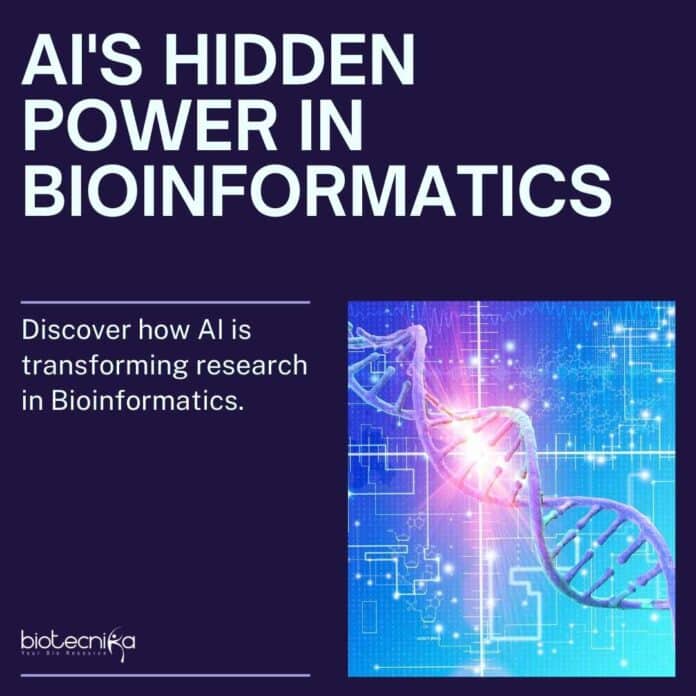AI In Bioinformatics – How To Use AI In Bioinformatics
In the exciting world of biology, Fernanda Garcia Fossa, a dedicated PhD student from Brazil, found herself facing a daunting challenge. She was studying nanotoxicology and needed to analyze countless images of human cells. But the process was painstakingly slow and prone to errors. She spent endless hours meticulously examining each cell image by hand, looking for subtle effects caused by silver nanoparticles on liver cells. It was overwhelming.
Then, one day, she stumbled upon a game-changer – an AI-based image-analysis tool called CellProfiler, developed at MIT and Harvard. Within hours, she had customized an algorithm to suit her research needs, and her life changed. The program began analyzing her images automatically, giving her more time for other crucial research tasks.
Fernanda’s story is just one example of how AI is transforming the field of bioinformatics. Bioinformatics involves using computer algorithms to decipher biological data and patterns. Traditionally, scientists have relied on these algorithms, but now they are increasingly turning to machine learning and AI to uncover hidden insights in sequences and images.
However, the adoption of AI in bioinformatics has its challenges. Many researchers lack the necessary skills for
managing data effectively, which, coupled with limited resources, slows down progress. This article will explore how you, as a BSc Biotech graduate, can harness the power of AI to enhance your bioinformatics skills.Get Familiar with AI Tools
AI tools, particularly image-analysis algorithms, have the potential to revolutionize the way researchers like you compare cell characteristics. AI speeds up the process through adaptive learning, allowing it to adapt to your specific needs. It can even identify differences or comparisons you might never have considered. The beauty of AI is that it converts complex biological images into numerical data, simplifying the analysis into a mathematics problem.
For instance, CellProfiler is an easy-to-use open-source tool that enables users to create customized workflows for automating their analyses. It can also integrate with machine-learning algorithms for more advanced tasks. Moreover, it’s evolving to incorporate deep learning, a sophisticated approach for recognizing intricate patterns in data.
Other user-friendly AI-based tools include ilastik, QuPath, and CDeep3M. These tools require little to no coding expertise, making them accessible to a broader audience.
Bridge Your Skills Gaps
If you aspire to create your AI tools, you’ll need to develop coding skills, particularly in languages like Python. Python is a versatile language that finds applications in various fields, making it a valuable skill not only in research but also in potential job opportunities outside academia.
To excel in the field, it’s essential to have a solid foundation in software engineering, mathematics, and statistics. These abilities will equip you with the essential set of tools required for success in bioinformatics.
Nonetheless, if coding appears intimidating, interactive tools such as ChatGPT can ease the transition. These tools enable you to experiment and ask questions, lowering the entry bar for newcomers.
Continuous Learning
Learning about AI is an ongoing journey. You can start by exploring free online tutorials and courses offered by universities and platforms like Coursera, edX, and Udacity. Well-known computer scientist Andrew Ng provides a comprehensive series of tutorials on machine and deep learning programming through Coursera.
Additionally, consider in-person learning opportunities, such as training sessions offered by institutions like the European Molecular Biology Laboratory (EMBL-EBI). These courses offer valuable hands-on learning experiences and chances to build your professional network.
Additionally, the French government backs a free online course managed by scikit-learn, which typically requires around 35 hours to finish.
Don’t Panic
AI technology evolves rapidly, but that doesn’t mean you have to chase the latest tools constantly. Many AI platforms, like scikit-learn, focus on conventional machine learning to simplify AI and make it accessible to a broader audience.
Rather than constantly adopting new tools, take a step back and assess what is genuinely useful for your research. Often, sticking to proven methods can be more productive than constantly adapting to the latest trends.
Learn from the Community
Gain valuable knowledge from the community by actively participating and engaging with fellow AI enthusiasts. Don’t shy away from contacting AI tool developers to seek insights and explore collaboration prospects. Many developers are eager to share their knowledge and improve their tools based on user feedback.
Online forums and communities, such as forum.image.sc, BioStars.org, and GitHub, are excellent platforms for seeking support, sharing resources, and collaborating with fellow bioinformaticians.
Finally, the best way to master AI is through practice. Platforms like Kaggle offer opportunities to participate in AI-related competitions and refine your skills. Embrace the notion that mistakes are an integral part of the learning journey.
To sum it up, AI is fundamentally transforming the field of bioinformatics. With the right tools, skills, and a supportive community, you can harness the power of AI to accelerate your research, uncover hidden insights, and make breakthroughs in the world of biology. Embrace the future of bioinformatics with confidence and curiosity!
AI In Bioinformatics – How To Use AI In Bioinformatics




























